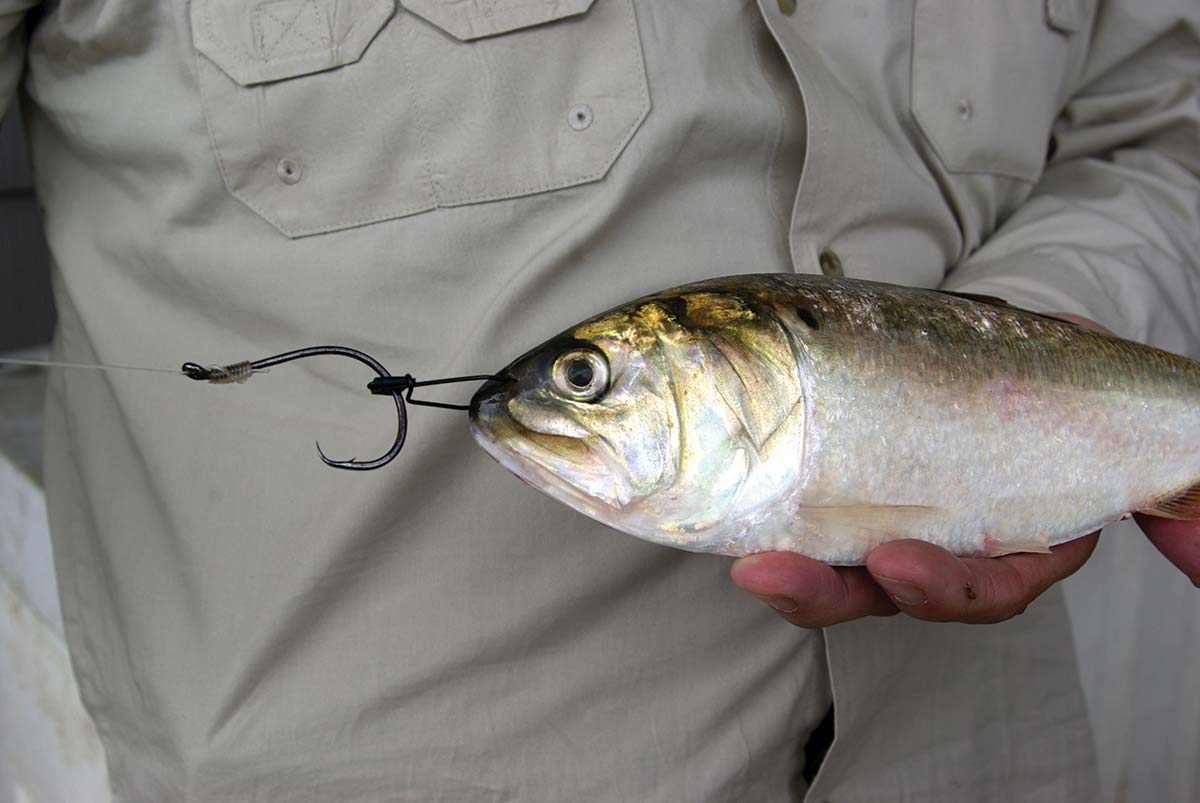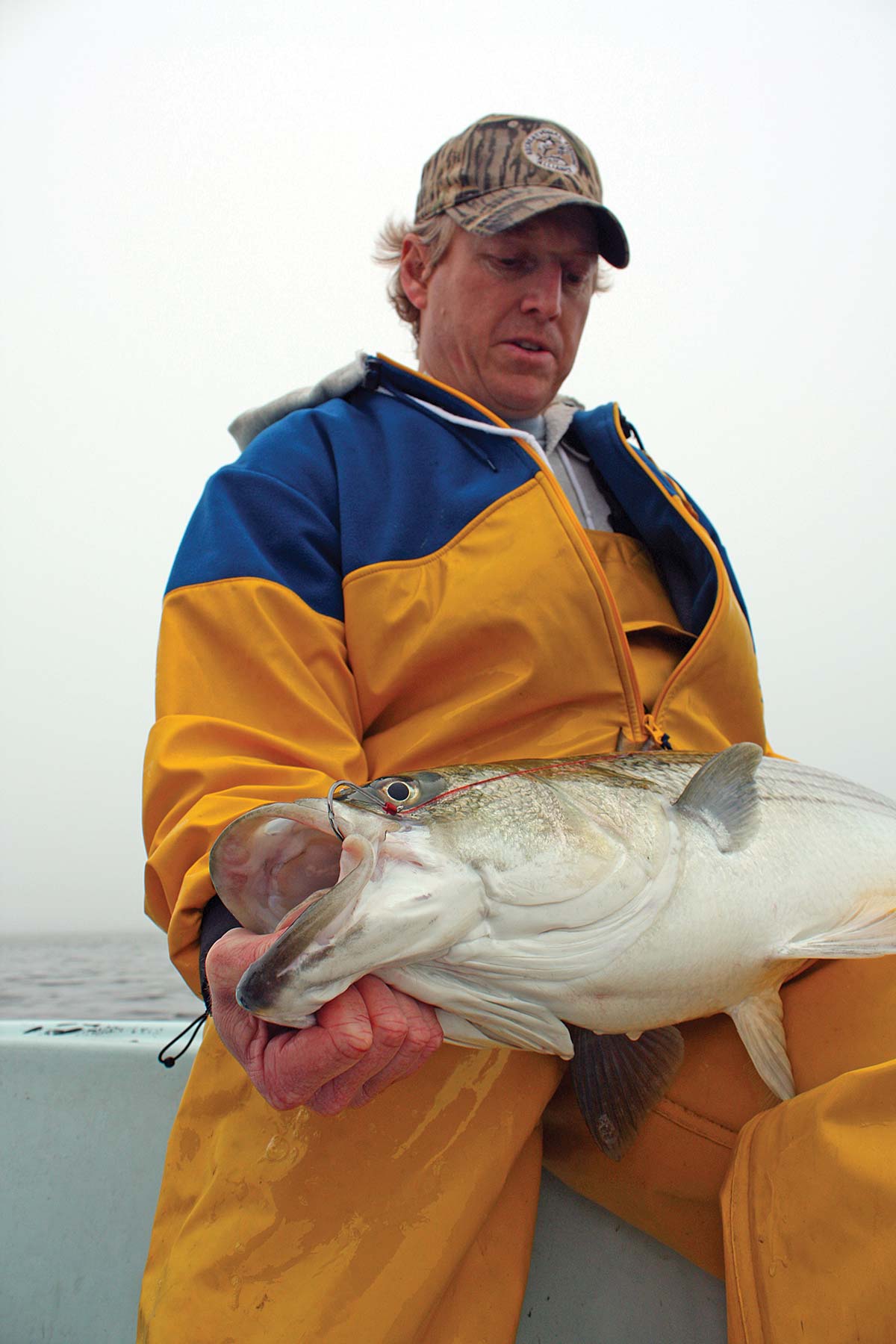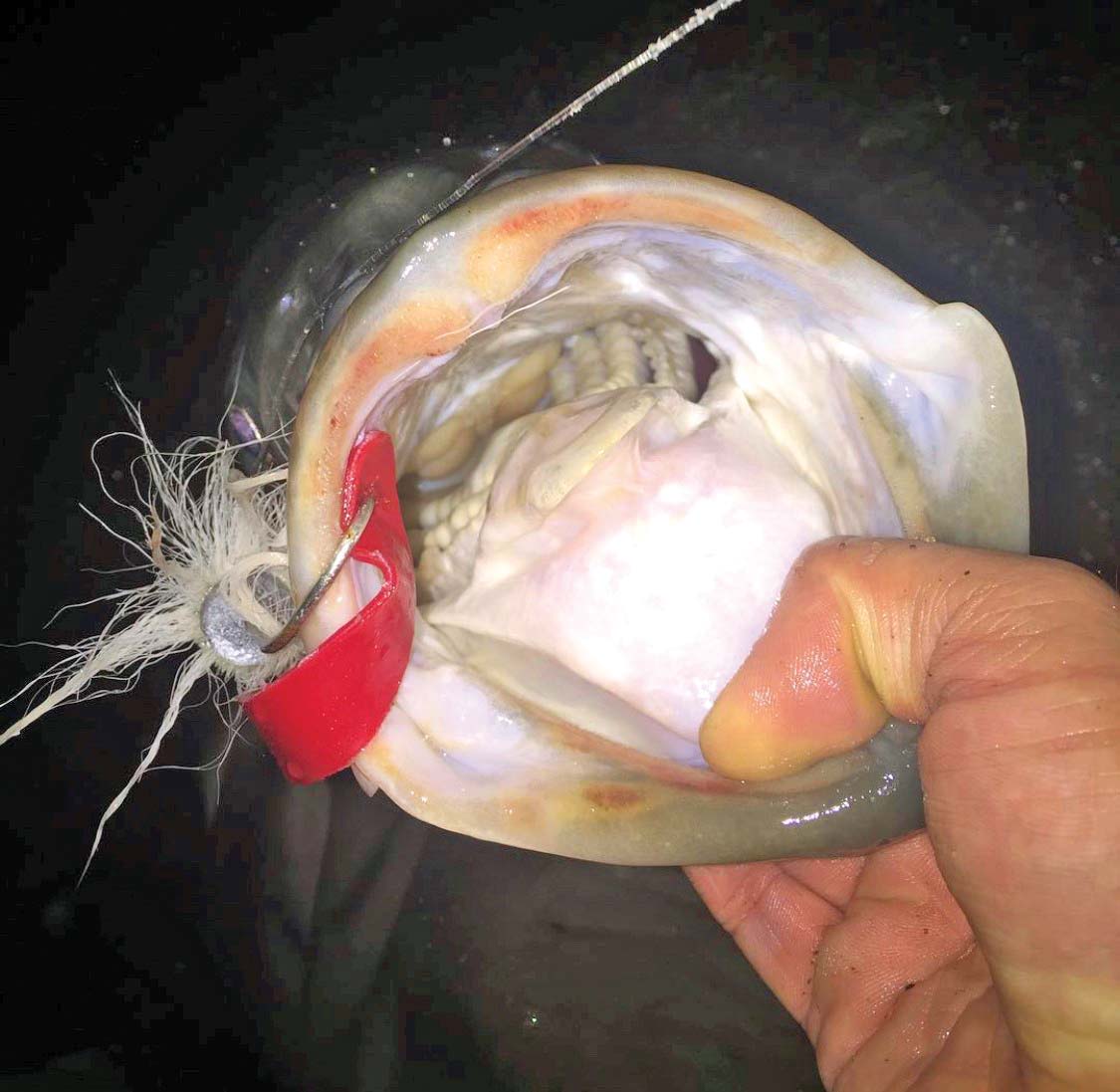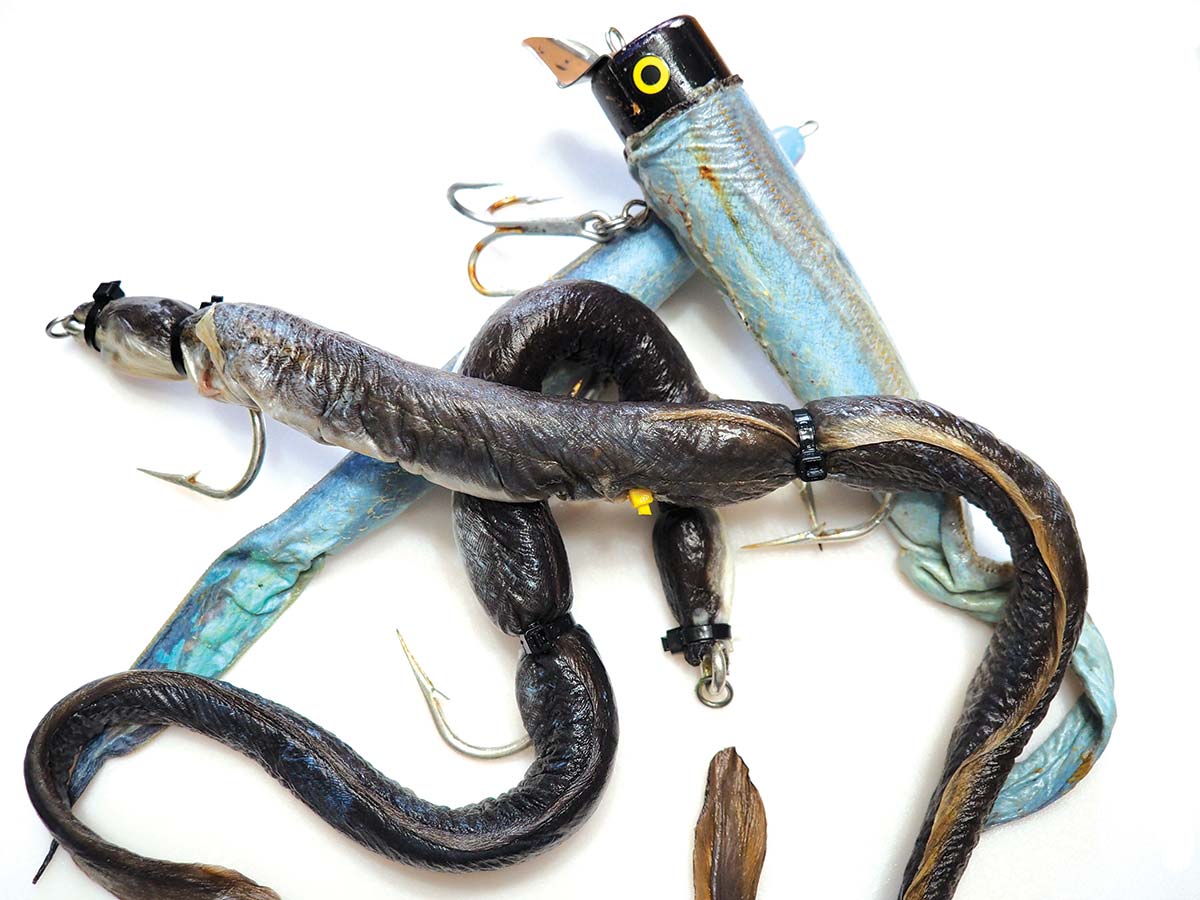The Fisherman’s editorial team reflects upon the new circle hook regulations in effect for 2021, and what they mean for striped bass anglers.

As of January 1, anglers targeting striped bass with natural baits in any Atlantic coastal state are required to use non-offset, inline circle hooks. Approved by the Atlantic States Marine Fisheries Commission (ASMFC) in 2019 and finalized in the fall of 2020, a ‘circle hook’ is officially defined as a non-offset hook where the point is pointed perpendicularly back towards the shank. The term ‘non-offset’ means the point and barb are in the same plane as the shank (e.g., when the hook is laying on a flat surface, the entire hook and barb also lay flat).
With two separate regulatory changes in the last decade on striped bass – the first representing a 25% reduction starting in 2015 and the second coming in 2020 with the transition to a “slot” fish – the conservation of large spawning class stripers has been a significant concern with ASMFC in recent years. In addition to the size and bag limit changes in ’15 and ‘20, the new “gear” restriction added to the mix for ‘21 reflects an effort by fisheries managers to reduce the mortality rate in the recreational community.
According to ASMFC, roughly 90 percent of the annual Atlantic striped bass recreational catch is released alive, of which 9% are estimated to die as a result of being caught (referred to as “release mortality” or “dead releases”). While catch and release fishing for stripers has been perceived to have a minimal impact on the population, a large component of annual striped bass mortality is attributed to release mortality, which is believed to have accounted for roughly 48 percent of total harvest in 2017, and 49 percent in 2018. Yes, that means almost as many stripers die from being caught and released as those that die in the fish box!
Numerous studies have shown that mortality rates on striped bass released using circle hooks (one to six percent) are far lower than when using standard ‘J’ hooks (nine to 18 percent). Thus, requiring anglers to use circle hooks any time they’re using natural baits (bunker, clam, worm, eels, etc.) when fishing for striped bass should ultimately reduce the number of fish that die after release.
But like a due date arriving on a big loan, now that circle hooks are required it’s leaving “borrowers” with a bit of agita and remorse. While hundreds of anglers may have turned up for the coastwide striper hearings in 2019 to weigh-in on the options, tens of thousands of striped bass fishermen who weren’t as connected to the process now have questions.
“What if I’m just targeting bluefish,” is probably the biggest of all (a query similarly posed by those casting poppers at breaking fish in the forbidden zone 3 miles from shore where fishing for striped bass is strictly prohibited.) The answer is simple; anglers targeting striped bass with natural baits in any Atlantic coastal state are required to use a non-offset, inline circle hook this year.
“Yeah, but what if I’m targeting bluefish (wink, wink)?”
Asked and answered blinky! But for some more frequently asked questions and “circular” commentary, here’s the editorial team from The Fisherman’s three regional editions.
Here, Hold My Bait
By Jim Hutchinson – New Jersey, Delaware Bay

While working out of our New York headquarters a dozen years ago, I was asked to participate in a group seminar with a few local angling personalities. As I’d already started using circle hooks for stripers by that time, I was asked to discuss the topic on stage. Based on the heckling I received by the assembled crowd and from the other seminar speakers, apparently no one believed my ominous forecast that we’d eventually be faced with such a gear restriction.
During my own trial and error, there were a few main issues to get past, number one being the natural inclination to cross the fish’s eyes on the hookset. Unlike the ‘J’ hook, the inward facing hook point on a circle hook is intended to catch the corner of the fish’s jaw, thereby decreasing mortality upon release. Keeping rods in rod holders (i.e., let Rodney hook your fish) is one good way to re-train.
Secondly, because of that circle hook design, it is critically important to keep the “gap” or “gape” – the area between and below the point and hook’s shaft – free from any obstruction from the bait. Burying a big chunk of bunker and hiding the hook point will result in lots of missed fish. I’ve found that bridling my larger chunk baits or live bunker (ultimatefishingfloat.info) helps keep the gap and the hook free to work as designed.
Some folks trying circle hooks early on found that stripers were still being gut-hooked. One reason for that is needlessly letting fish run for a 5- to 10-second count before engaging the reel. When a striper actually swallows your rigged bait, a circle hook can still hook fish deep. Also leading to early gut hooking problems was the fact that many early hook entries into the striper market had a slightly offset point that still functioned similar to a ‘J’ hook. All striper hooks you’ll find by major manufacturers in 2021 should be completely inline, so the “offset” problem really shouldn’t exist now unless you’re using older hooks.
Problematic for New Jersey, Delaware and Pennsylvania anglers this spring when soaking worms or clams along the bays and rivers is the fact that there really weren’t many baitholder style circle hook options on the market in 2020 – that being a hook designed with small barbs along the hook shank to hold soft baits in place. The folks at Eagle Claw said their Lazer Sharp Striped Bass Inline Circle Hook Rigs will be complemented by inline baitholder style circle hooks this winter. VMC came out with a B-Lok Bait topper to keep live eels and live bunker from riding up on the shank, and may also delve into the needs of the worm and clam crew this year. The 2020 pandemic had a huge impact on manufacturing capabilities, so it may take time for the major hook manufacturers to address our deadstickers.
For those in need of a quick fix, look for Allen D. Riley’s Improvise & Adapt: Add A Baitholder To Circle Hooks for an easy hack for adding baitholding ability to the inline circle hooks that don’t have baitholder barbs.
YO Buck!
By Matt Broderick – Long Island, Metro New York
It is set in stone that come this season it will be mandatory that anglers using natural baits for striped bass fishing to use inline circle hooks. That includes eels, rigged eels, bunker, herring, mackerel, squid, spot, bloodworms, sandworms, clam, and any other bait that is applied to a hook.
One frequently asked question is what about bucktails with pork rind. Given the way the current regulations are set (in terms of the letter of the law), if you use a bucktail in combination with pork rind, it is required that you use a circle hook bucktail. The Atlantic States Marine Fisheries Commission (ASMFC) considers pork rind a bait that falls under the same category as the natural baits listed above.

After a quick internet search to check if they even exist (they do), it made me think about how I would even go about fishing one of these. With a normal circle hook you’re supposed to reel into it. I’m assuming the circle hook bucktail is to be fished the same way. Instead of that sharp hookset that we’re all used to we would just simply keep reeling. Definitely not a natural thing to do when it comes to fishing bucktails. This unorthodox method would take some getting used to. Certainly from my perspective as someone who is used to instantly setting the hook when I feel that tap, it’s reasonably safe to assume that many others would react the same way.
Unlike actual baits that live in or by the ocean, pork does not. The rind itself offers a visual trigger behind the bucktail that helps a striped bass make that split second decision to strike the offering. Clearly there are differences in a chunk of bunker or wriggling eel and the flash of strip from a properly worked bucktail or jig. And, since I don’t expect folks to go off frantically searching for circle hook bucktails, the simple solution is the artificial trailers which have become quite popular in recent years as actual pork rinds has become harder to find. Two of my favorites that work very well are Fat Cow Strips and Otter Tail baits. Both companies offer a vast line of shapes and colors that work in a variety of different situations. They are 100 percent synthetic and are absolutely allowed in combination with a standard bucktail.
In many ways these artificials are actually better than the natural pork. I can leave the baits on for weeks at a time and they still have offer the same action they did out of the jar. They don’t stretch out or dry up after a long fishing session; I can’t tell you how many times I’ve left a piece of rind on my hook after a night of fishing and had to razor blade it off due to it drying out. Bucktailers should not fret over this new regulation. If you have not switched to the alternative trailers, I can assure you they are an improvement over pork rind.
Skins & Riggies
By Toby Lapinski – New England
We all knew the new circle hook regulation was coming down the road for 2021 and no amount of complaining, chest pounding or blind social media rage is going to change that fact. That said, even I was blindsided by the absurdity to which the Atlantic Striped Bass Board of the ASMFC would pass the final ruling.
Going into the 2020 fishing season I spoke with several New England state fisheries representatives and we collectively agreed that the final ruling would at the very least include exemptions for certain gear types where a circle hook either doesn’t work or is unnecessary. These included techniques such as adding a sandworm to a tube and worm rig, draping an eelskin over a plug and fishing a two-hook rigged eel. In each of these examples there is nearly a zero percent chance of deep-hooking a striped bass which is the reason behind the circle hook rule in the first place. (I’d be willing to bet that if a study was to be done that more fish are deep-hooked with a circle hook and chunk bait than any of these three examples, but that’s a discussion for another day.)
So back to the point, circle hooks are in place for the season and we as law-abiding striped bass anglers (there are a few of us left out there, right?) must follow the rules as they are written, for the time being anyway. Going forward, there will be public hearings and comments periods state by state, and this is when we can all express our views on the subject in a calm and intellectual manner.

When it comes to the use of an eelskin, I hate to say it but I feel that we may be out of luck as far as an effective way to continue to employ this deadly tactic while also following the letter of the law. For those uninitiated readers out there (I am looking at you, ASMFC Board members) since the dawn of the modern era of striped bass fishing, anglers have been taking dead eels and removing the skin to enhance the appeal of an artificial lure. The skin is cleaned of all meat and placed in a brine solution for anywhere from a few weeks to a few years to preserve it. Once preserved, the skin is draped over an existing artificial lure and most, if not all of the original hooks are replaced on the lure which is then fished in exactly the same way as it would be without an eelskin. There is absolutely no tendency for a fish to be any more deeply hooked on an artificial lure with the skin as it would be without, and there may actually be a valid argument that since most anglers actually reduce the number of hooks on an eelskin plug, that it inflicts less potential damage on a fish! Wherein the problem arises here is that there is no effective method of which I have been made aware in which a circle hook may effectively be added to an artificial lure which also fishes well with an eelskin.
Next up we have rigged eels. Here is where I am not so sure that we are out of luck, yet I am already seeing anglers on social media looking for ways to circumvent the rules. What evidence do we have that a circle hook will or will not work when used in a rigged eel? I, unfortunately, have no evidence one way or the other; only speculation. Where I feel we may be somewhat ok here, albeit with slight modifications to the rigging and fishing process, is that trolling of natural baits for pelagics can be quite effective with circle hooks so my hope here is that there are some tips and tricks we can borrow from our bluewater brethren. I have already set out to unlock the secrets here, and I’ll be sure to report back with my findings.
Check out The Fisherman’s recent webinar on Circle Hooks & Stripers for more information.




